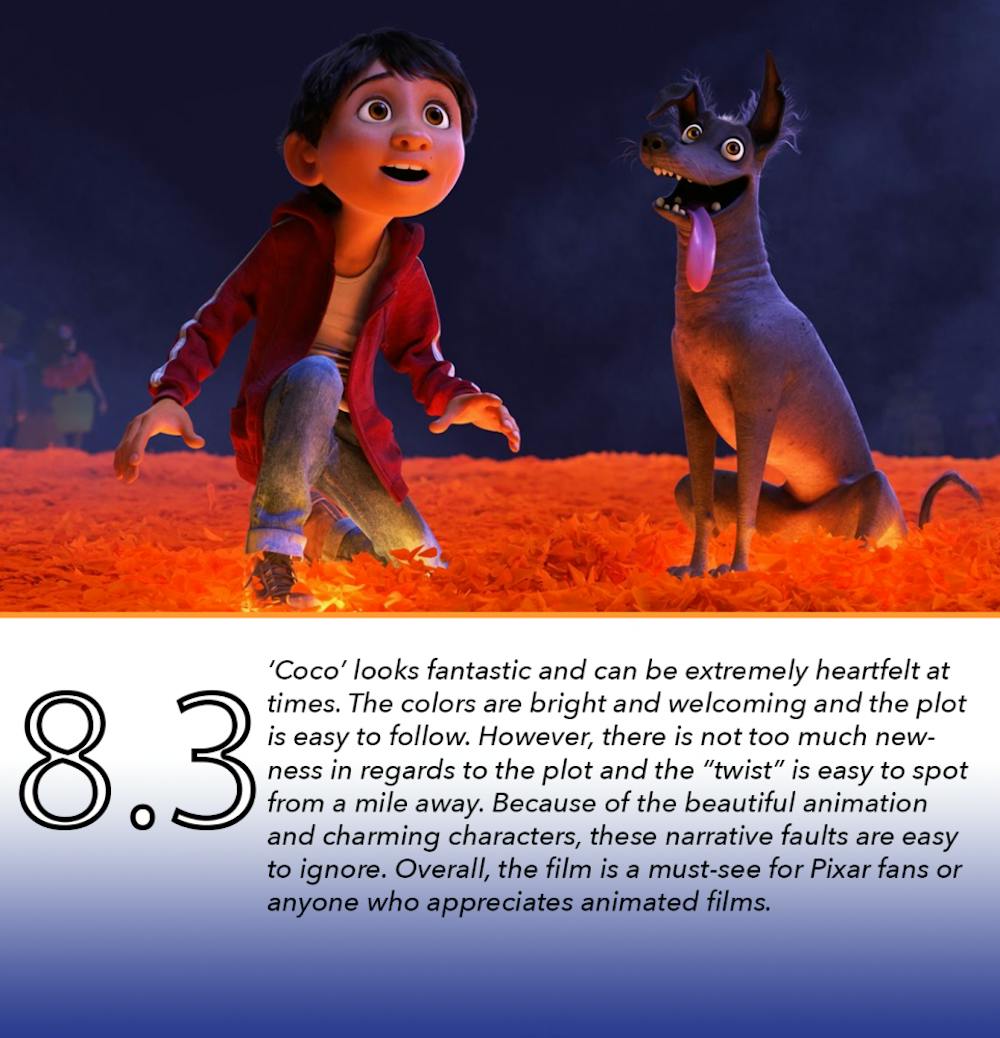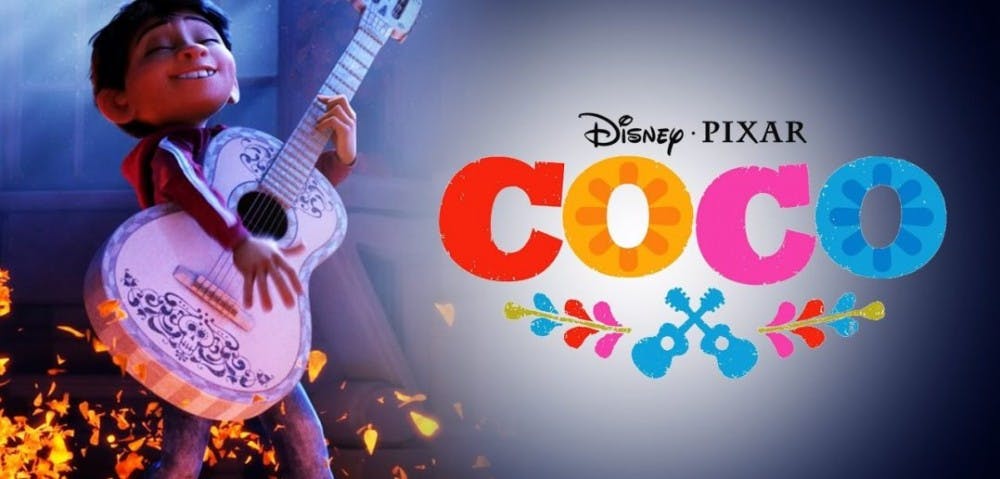You may not have noticed, but Pixar has been in a bit of a rut over the past few years. While hits like Inside Out have managed to captivate audiences, the influx of sequels has notably regressed the once-innovative and original Pixar films of late. Originality seems to have been shoved aside in favor of thoughtless sequels and blatant retellings (Toy Story 3 is literally Toy Story 2 with a new skin). With other animation companies such as Disney and Dreamworks stepping up their 3D animation, Pixar seems to be lessening in importance in the growing animation market.
With all of this in mind, Coco serves as much-needed reminder regarding Pixar’s creativity and dedication to animated greatness.
A whimsical journey to the Land of the Dead
Coco is a relatively straightforward film. Set in a small Mexican town, our protagonist, the 12 year-old Miguel has a major love for music. Sadly for him, due to an old family conflict, music is essentially banned within Miguel’s family. This doesn’t deter our young hero who secretly worships the singer Ernesto de la Cruz and practices guitar away from the judgmental glares of his family.
Around this time, Día de Muertos, or The Day of the Dead, is set to begin. On the same night, a talent show gives Miguel visions of grandeur. When he proposes playing guitar at the festival, Miguel is immediately rebuked by his grandmother leading to a heated family dispute. This results in the the discovery and subsequent destruction of Miguel’s secret guitar.
After the family spat, Miguel comes to the conclusion that he is actually the great-great-grandson of de la Cruz. This restores his motivation and Miguel infiltrates de la Cruz’s gravesite to borrow the singer’s guitar and perform at the festival.
Once Miguel strums the guitar for the first time, he finds he is no longer visible to the living. During Día de Muertos festivities that are simultaneously going on, Miguel is surprised to see his dead ancestors. They are just as surprised to see him and take him to the Land of The Dead to remedy the issue. In the Land of the Dead, Miguel discovers that his great aunt Imelda has been unable to enter the Land of the Living because he had previously knocked her family photo off the ofrenda, resulting in a family curse. Additionally, Miguel must return home before sunrise or he will be trapped forever. Imelda agrees to send Miguel home under the conditions that he place her photo back on the ofrenda and that he give up music forever.
Miguel, unwilling to give up music, makes a run for it. He decides that de la Cruz would gladly send him home without the condition of abandoning music. Along the way, Miguel runs into Hector, a sketchy skeleton who claims to know de la Cruz. Together, the two brave the Land of the Dead and hope to send Miguel home before he is trapped in the Land of the Dead forever.
Now admittedly Coco does not have the most original plot. The Book of Life did a similar film featuring Día de Muertos years ago, and the similarities have caused controversy amongst filmgoers. However, I think it’s fair to keep in mind Día de Muertos is a popular holiday that makes for interesting storytelling, so simply having the same holiday featured isn’t necessarily an unreasonable offense. On the other hand, Día de Muertos is definitely overused in the media and it would be great if storytellers would showcase other aspects of Mexican culture.
Also in regards to the plot, there are definitely some cliches that need to be mentioned outside of using Día de Muertos. The liar revealed is a trope (that I find really annoying) that pops up here in a predictable manner. I won’t spoil the reveal the movie sets up, but anyone who has seen any film ever should be able to spot it in Act 1 during the point of attack. Does this make the film bad? No. Coco is really great despite it’s simplicity. Though predictable, there is a ton of emotion crammed into this animated piece that is likely to make moviegoers tear up.
Pixar’s animation team does it again
Cutting straight to the chase, Coco looks incredible. Between the lighting, the character models, and the fluid motion, everything is incredible to look at. According to IMDb Coco has set the record for Pixar being the longest Pixar film in production, and the effort definitely shows, especially in the scenes showcasing the Land of the Dead.
Director Lee Unkrich comments about the use his research of Mexican culture and his use of color in the film, “I’d seen it portrayed in folk art. It was something about the juxtaposition of skeletons with bright, festive colors that captured my imagination. It has led me down a winding path of discovery. And the more I learn about Día de Muertos, the more it affects me deeply.” Personally, due to the masterful use of color and design, I would consider Coco to feature the best looking animation Pixar has done thus far.
For those (like me) who actively aimed to avoid the trailers and keep the film an absolute surprise, be forewarned that the previews prior to the show will show you a lot of the grand-looking environments.
Is Coco a ripoff of The Book of Life?
Let’s go ahead and get this out of the way; yes Coco and the 2014 animated film The Book of Life share a ton of similarities. Both films feature Día de Muertos as well as Hispanic characters and have a strong emphasis on music.
In many respects, Hispanic culture has absolutely been given the shaft in Hollywood and media in general. Hispanic culture is rarely talked about (outside of stereotypes), and Hispanic protagonists are largely nonexistent. The Book of Life received praise for focusing on Hispanic culture in a respectful manner and for the largely Hispanic cast and crew including director Jorge R. Gutierrez, Guillermo del Toro, Diego Luna, Zoe Saldana and Jorge R. Gutierrez. By contrast, when Coco was first showcased in 2015, the only crew involved were white. While this was later fixed, this does demonstrate the overwhelmingly white hand that went into the initial crafting of the film.
In terms of who copied who, this is where things get a bit tricky. The Book of Life began production in 2012 and later released in 2014. As we all know, Coco released three years later. However, while many love to claim theft, Coco was actually announced in early 2012, the same year The Book of Life began production. After the initial announcement, updates on Coco remained fairly silent until December 6, 2016 when Entertainment Weekly dropped a plot synopsis for the Pixar film.
No matter who released the film first, I would argue that Coco looks far more professionally done and provides more of a heartfelt narrative than its competitor. If you liked The Book of Life, I’d wager you’ll probably like Coco too.

Featured image from WDW News Today
For more entertainment related content, visit us at Byte Bsu!



















